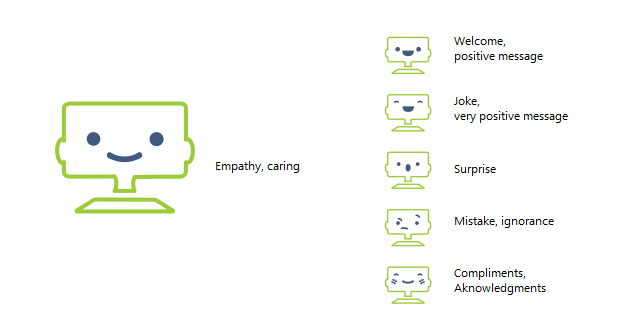
The rise of chatbots and other conversational robots is nothing new. In 2015, companies began deploying them massively on their websites or mobile apps, in order to relieve pressure on their call centres.
Since then, their uses have multiplied; product recommendation, employee support (IT, HR, helpdesk, legal), welcoming visitors, home automation… Today, numerous companies are equipped with one or more bots, and are always exploring new ways to use them.
Far more than just a passing trend, these virtual assistants have real advantages for both companies and end users; rapidly accessible information, reduced wait times, a smoother processing of requests, reduced contact volume… Yet, sometimes users are disappointed; misunderstandings, poor suggestions, repetitions… Some bots clearly don’t live up to our expectations.
To avoid user frustration, it is essential to work on your bot’s conversational design. Read on to find out how.
Spending time on conversational design to encourage the adoption of your bot
Conversational design includes all the steps necessary to making interactions between a human and a machine as smooth and efficient as possible. To create your User Interface (UI), you must first define the User Experience (UX).
UX takes all of your end users’ needs into consideration, to offer them the best possible experience. Your bot should adapt to them, and not the other way round. UI is the experience’s visible medium, a direct link between the user and product. A good UX/UI makes all the difference.
Understanding your users and their needs
The first step when creating a chatbot is to put yourself in your end users’ shoes by creating personas. In other words, identifying your target and establishing their personality, habits, motivations and frustrations. Next define all the possible expectations from these personas. Only after this step can you start to create a bot’s knowledge base.
Define your chatbot’s personality
Name, avatar, conversational style, tone… Everything should be thought out with your end users’ profile in mind, sticking as closely as possible to your company’s brand image. As such, a chatbot can be funny, friendly or more formal.
Knowing the context
Your bot should be able to contextualise user intent and bounce back with suggestions that make sense according to the user’s profile and the bot’s use. You can also inject your bot with “emotions”, via an animated avatar or emojis. This will make it appear more human and friendly, and users will enjoy chatting with it!

Guiding your users
When starting a conversation, your bot should first and foremost introduce itself and then specify the perimeter within which it operates, to avoid any frustrations. The bot is not supposed to have an answer for everything! The conversation could start for example by, “Hello, I’m Leo, your virtual adviser. I’m here to answer any questions you may have about tax deducted at source”.
The chatbot should also guide your users during a dialogue, through the misunderstandings and potential actions and requests. Should an ambiguous situation arise, the bot should be able to specify the user’s intent and transfer them to a human when unable to answer. All of these different scenarios are defined right at the beginning of the project and integrated into the bot’s back-office to be able to handle 80% of end user interactions.
Generating smooth conversations
To guarantee the best possible experience, your bot must be able to generate a smooth conversation, as natural as possible. Slot filling can be an interesting functionality to use here; it enables the bot to gather information or elements throughout the conversation, without necessarily following a question/answer sequence, that are needed to provide a response to a user’s intent.
For example, to respond to the intent “I would like to order a pizza”, you can configure a “toppings” slot and a “number of people” slot. If the user says:
- “I would like to order a pizza”: the bot asks the user to specify which toppings and for how many people
- “I would like to order a cheese pizza”: the algorithm fills in the “toppings” slot with “cheese” and the bot asks the user to specify for how many people
- “I would like to order a cheese pizza for 4 people” OR “I would like to order a pizza for 4 people with cheese”: the algorithm fills in the “toppings” slot with “cheese”, the “number of people” slot with 4, and the bot can continue with the order
And what about voice?
You have probably already exchanged with a vocal assistant, which is hardly surprising given that they are a hot topic of discussion at the moment and have invaded our everyday lives; on our smartphones with Siri or Cortana, via connected speakers like Google Home and Amazon Echo, or other connected devices. Gartner estimates that 20% of interactions will occur via vocal assistants in 2019. A figure that makes sense when you consider that talking is 3 times quicker than typing on a keyboard.

Voicebots are based on the same technology as NLP (Natural Language Processing) and endowed with the same capacities as chatbots, the only difference being that their interactions are vocal. They do however also include two extra steps: voice recognition (Speech-To-Text) and vocal synthesis (Text-To-Speech).
Voice design, an essential step
To create a voicebot or a callbot (a voicebot via telephone), you can follow the same steps as for a chatbot.
Interactions between humans and robots are nevertheless different because the user interacts using speech instead of writing. The choice of words, syntax, utterances and expressions are thus all the more important. In this step, it is essential to understand the difference between talking and writing before creating your bot’s knowledge articles and the related decision trees.
The keys to a good Voice UI, according to dydu:
- Choosing the right voice
- Being as natural as possible: tone, nuances, interruptions
- Keeping it short and concise: the user’s time is precious
- Being cooperative and empathetic
- Making suggestions
- Varying words and expressions to avoid repetitive sentences
- Using and understanding common words and human expressions: “Hmm, right, I see…”, “Perfect”, “Noted, thanks”
- Testing, retesting and re-retesting the bot ?
Whether used alone, or in addition to text and images, speech can truly offer a rich user experience, as long as you respect the best practices when it comes to voice design.






